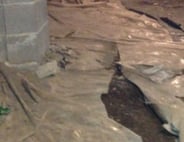So often people inquire about, "Visqueen" vapor barrier. What they are really asking for is some sort of plastic sheeting to use as a vapor barrier/retarder.
Why are vapor barriers used under concrete you ask...Moisture that is in the ground slowly rises to the surface. This is problematic if you are putting tile or carpeting on top of the concrete in the way of flooring. Vapor barriers AKA vapor retarders are a sheet of plastic that blocks the water from reaching the concrete slab.
Can any type of plastic work for this purpose...not exactly. You see while you may think a 6-mil layer of Visqueen is sufficient, it simply isn't. This liner is not water tight. Additionally, 6 mil plastic gets damaged during the placement of reinforcement and concrete which will create holes that will let the water right up.

Visqueen has become one of the generic names for plastic sheeting, just as Kleenex has become the generic name for tissue. When someone asks for Visqueen, they are referring to a lesser grade of plastic sheeting. The plastic sheeting known as Visqueen has become a generic name for Construction and Agricultural Grade Polyethylene sheeting (C&A film). C&A film contains up to 25% post consumer recycled content, and is made from the least expensive resins available at any given time. While it is excellent for use in many projects, it is not ideal for any use that requires sustained strength such as a tarp or for use as a vapor/moisture barrier or retarder. People will often do a search for "visqueen vapor retarder", or fire retardant visqueen" when they may be looking for an engineered plastic. An engineered plastic is one that is intentionally designed to meet certain measurable criteria to insure its suitability for the job it is intended for.
When looking for a vapor retarder/barrier, we recommend an engineered film like Raven Industries VaporBlock Plus for this purpose to block as much of the moisture, radon, methane and VOC's as possible. VaporBlock Plus engineered films are designed to last forever buried in the soil, where C&A film often completely breaks down within a couple of years. Have you ever dug up some old black plastic? Remember how torn and crusty it was? It's important that today's vapor/moisture barriers or retarders should pass the ASTM E 96 Class A, B and C (standard for under-slab vapor retarders in contact with soil or granular fill). ASTM E 96 measures in part the "permeance" or how much water can pass through the vapor barrier. You need a liner that is 0.3 perms or less. In terms of thickness, 10 mils and above will offer much better protection and resistance to moisture transmission. If you need to over-lap the vapor retarder, 6 inches at the seams, taped and sealed around column and the like.
The bottom line is doing your due diligence regarding vapor barriers and selecting one that is not a "visqueen vapor barrier" and go with liner that is engineered and tested to do the best job for the application.






